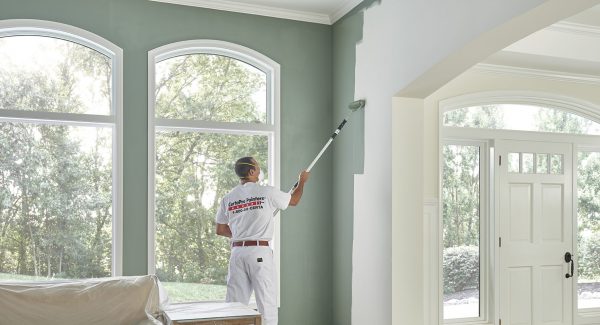Exploring the Different Sorts Of Paint: A Guide for each Task
Checking out the various kinds of paint is crucial for attaining the desired end result in any task. From water-based options that provide ease to oil-based paints known for their longevity, each choice has its benefits. Specialized paints can include one-of-a-kind appearances or coatings, while green choices accommodate those looking for sustainability. Recognizing these differences can significantly impact the success of a painting endeavor. What variables should one take into consideration when making the right selection?
Recognizing Paint Kinds: Oil-Based vs. water-based
Paint types can considerably impact a project's outcome, and recognizing the differences in between water-based and oil-based paints is crucial for informed decision-making. Water-based paints, frequently described as latex paints, are made up of water as the key solvent. They dry quickly, discharge less unpredictable organic compounds (VOCs), and are very easy to tidy up with soap and water. This makes them a popular selection for indoor applications and settings where air top quality is a problem.
On the other hand, oil-based paints make use of organic solvents, giving a durable, shiny surface suitable for surface areas exposed to use and tear, such as trim and cabinets. They take longer to dry, require mineral spirits for cleaning, and have a more powerful odor. corpus christi paint store. Picking in between these 2 types depends on the particular requirements of the job, thinking about variables such as wanted surface, application environment, and simplicity of upkeep. Each type has distinctive benefits and restrictions, leading the selection procedure
The End Up Matters: Choosing Between Matte, Satin, and Gloss
When selecting a paint surface, the option in between matte and shiny choices substantially influences both appearances and functionality. Matte coatings use a subtle, non-reflective look that can hide surface area blemishes, while shiny finishes give sturdiness and simplicity of cleansing. Comprehending the advantages and considerations of each can aid in making an educated decision for any kind of paint task.
Matte Finish Advantages
Although many house owners debate the qualities of different coatings, matte paint uses unique advantages that make it a prominent selection for both exterior and interior applications. Among the key advantages of matte surface is its ability to hide surface imperfections, developing a smoother look on wall surfaces. This high quality is specifically helpful in older homes or areas with unequal surfaces. In addition, matte paint soaks up light instead than mirroring it, which can improve the aesthetic of a space by giving a much more advanced and low-key look. Matte finishes are usually less complicated to touch up than glossier alternatives, as they can mix extra effortlessly when applied over existing paint. Overall, matte paint is an excellent choice for those looking for a refined and elegant surface.
Glossy Complete Factors To Consider
A glossy surface can drastically change the assumption of an area, using a reflective and streamlined quality that enhances both shade vibrancy and light within a space. This finish is often favored for high-traffic areas and surfaces like bathroom and kitchens, where resilience and ease of cleaning are vital. Nonetheless, its reflective nature can highlight blemishes on wall surfaces, making correct surface area prep work crucial. Shiny paints additionally have a tendency to reveal smudges and fingerprints quicker, requiring routine maintenance. Additionally, illumination plays a considerable duty; in bright settings, a glossy surface might develop glare, influencing the general aesthetic. Subsequently, mindful factor to consider of the certain application and setting is very important when choosing a shiny coating for any kind of job.
Specialty Paints: When to Use Distinctive or Chalk Paint
Specialized paints, such as textured and chalk paint, deal unique visual and practical benefits that can improve numerous surface areas. Textured paint is optimal for creating deepness and measurement on walls, concealing blemishes while including a three-dimensional feeling. It is especially beneficial in high-traffic locations where durability and visual interest are necessary.

Both sorts of specialty paints can transform rooms, but picking the appropriate one depends upon the desired impact and surface area needs. Textured paint might fit bigger locations, while chalk paint can revitalize smaller sized items, showcasing creative thinking and individual design in any type of task.
Outside Paints: Safeguarding Your Surface Areas From the Components
Outside paints are necessary for safeguarding surfaces against numerous weather problems. Understanding their weather resistance features, correct surface prep work needs, and efficient application methods can considerably enhance longevity and efficiency. This area will certainly lay out crucial considerations for choose and making use of outdoor paints effectively.
Climate Resistance Includes
Climate resistance is an important function of exterior paints, as it identifies how well surface areas can withstand the extreme elements of nature. High-grade exterior paints are developed to stand up to damage from UV rays, moisture, and temperature level fluctuations. UV resistance warranties shades remain vibrant over time, protecting against fading and discoloration. Moisture resistance shields versus mold and mildew, which can endanger the integrity of surfaces. Furthermore, paints with exceptional temperature level resistance can expand and contract without breaking, preserving their safety qualities. When picking outside paints, it is important to consider these weather condition resistance features, as they add to the long life and resilience of painted surfaces, making sure they stay cosmetically pleasing and useful in spite of direct exposure to the elements.
Surface Area Prep Work Demands
Correct surface preparation is an essential action in attaining the very best outcomes with outside paints. To ensure ideal adhesion and longevity, surfaces have to be thoroughly cleaned, getting rid of grease, dirt, and mildew. This can be achieved using a stress washer or a scrub brush with an appropriate cleaning service. When cleaned, surface areas should be evaluated for any type of peeling or flaking paint, which should be scuffed away to develop a smooth structure. Fixing any kind of splits or openings is additionally vital, as these can enable dampness seepage. Furthermore, fining sand harsh areas promotes much better paint attachment. Finally, using a primer suited for outside usage can boost the paint's efficiency, guaranteeing a durable coating that stands up to the components. Correct prep work is key to an effective outside paint task.
Application Methods Tips
While applying outside paints, it is crucial to make use of efficient methods that assure surfaces are well-protected versus the aspects. Choose the best day for painting; low humidity and moderate temperatures improve attachment and drying out. Prepping the surface extensively-- cleansing, fining sand, and priming-- makes certain better paint bond and toughness. Using top notch brushes or rollers can give a smoother surface, while spray painting might cover big locations successfully. Using paint in thin, also coats protects against drips and runs. It is recommended to comply with producer directions pertaining to drying out times between layers. Lastly, verify appropriate air flow during application to help with drying out and lessen exposure to fumes. These methods greatly enhance the longevity and efficiency of outside paint.
Eco-Friendly Options: Low-VOC and Zero-VOC Paints
As consumers become increasingly knowledgeable about the ecological effect of their selections, zero-voc and low-voc paints have actually become prominent options. These paints are created to include less unstable natural compounds (VOCs), which are chemicals that can vaporize right into the air and add to air pollution and illness. Low-VOC paints normally contain a restricted amount of VOCs, while zero-VOC paints have negligible degrees, making them more secure for both outside and indoor usage.
The benefits of making use of zero-voc and low-voc paints expand past ecological considerations; they also boost indoor air top quality, minimizing the danger of sensitive responses and respiratory system problems. Several producers currently provide a variety of shades and coatings in green choices, making it much easier for customers to locate suitable products for their projects. By opting for these paints, individuals can add to a much healthier environment while still accomplishing the aesthetic they want in their areas.
Devices and Techniques for a Perfect Application
Attaining a flawless paint application needs the right devices and techniques, which can considerably improve the outcome. Selecting the proper brush or roller is vital; brushes work well for edges and elaborate areas, while rollers cover larger surface areas successfully. Using high-quality materials assures better paint distribution and reduces streaks. For optimal outcomes, surface prep work is essential. This includes cleaning, fining sand, and priming surface areas to advertise bond.
Technique also plays a considerable duty. The "W" method with a roller assists to equally disperse paint, while long, smooth strokes with a brush prevent noticeable lines. Working in areas enables far better control and blending. Furthermore, applying slim coats is preferable to thick layers, reducing the risk of drips and uneven appearances. Ultimately, preserving a damp edge during application helps attain smooth changes in between locations. By incorporating these tools and strategies, one can accomplish a specialist and refined surface.
Tips for Keeping and Caring for Your Painted Surfaces
Proper upkeep and care of coloured surface areas can substantially prolong their life-span and maintain their appearance. Normal cleaning is here vital; utilizing a soft cloth or sponge with light soap and water can get rid of dust and dust without harming the paint. It is suggested to prevent unpleasant cleansers or rubbing pads, as these can damage the surface. Furthermore, applying a fresh coat of paint every few years can revitalize the shade and safeguard against wear.
For outdoor surface areas, checking for indicators of peeling off or fading consistently is necessary. Without delay resolving any type of issues avoids more damage. In areas vulnerable to moisture, such as restrooms, utilizing mold-resistant paint and making sure correct ventilation can aid preserve the integrity of the paint. Finally, using protective coatings can shield against UV rays and stains, guaranteeing that repainted surface areas stay enticing and dynamic for many years ahead, inevitably enhancing the total visual of the area.
Often Asked Inquiries
Can I Mix Different Kind Of Paint Together?
Blending different types of paint is typically not advised, as it can lead to problems like bad adhesion, irregular appearance, or unexpected chain reaction. It's best to make use of compatible paints for optimal outcomes and toughness.

Just how Do I Appropriately Store Leftover Paint?
To properly store remaining paint, seal the container securely, tag it with the day and color, and maintain it in a great, completely dry area far from straight sunshine and severe temperatures for optimal conservation.
What Is the Best Method to Throw Away Extra Paint?
The very best method to take care of extra paint is to inspect regional guidelines, as lots of locations have actually marked contaminated materials centers. Conversely, think about contributing useful paint to community organizations or schools for their projects.
Exactly How Can I Inform if Paint Is Still Great to Utilize?
To determine if paint is still great, examine its odor, color, and uniformity. If it appears apart, has an undesirable odor, or shows substantial changes in texture, it's likely no more functional.
Exist Age Restrictions for Buying Paint Products?
In several areas, there are no particular age constraints for acquiring paint items. Some shops might require consumers to be at the very least 18 years old, especially for items consisting of solvents or dangerous materials.
Paint types can noticeably influence a job's result, and comprehending the distinctions in between water-based and oil-based paints is necessary for notified decision-making. Water-based paints, commonly referred to as latex paints, are made up of water as the main solvent. In contrast, oil-based paints make use of natural solvents, providing a long lasting, glossy surface perfect for surface areas subjected to put on and tear, such as trim and cupboards. Specialized paints, such as distinctive and chalk paint, deal one-of-a-kind visual and functional benefits that can boost different surfaces. In areas susceptible to dampness, such as washrooms, using mold-resistant paint and ensuring proper ventilation can help preserve the honesty of the paint.